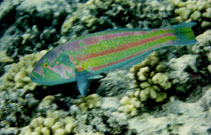| Family: |
Labridae (Wrasses), subfamily: Corinae |
| Max. size: |
46 cm TL (male/unsexed); max.weight: 1,210.0 g |
| Environment: |
reef-associated; marine; depth range 0 - 10 m |
| Distribution: |
Indo-Pacific: Red Sea and East Africa (Ref. 4392) to the Hawaiian, Marquesan, and Easter islands, north to southern Japan, south to Lord Howe, Kermadec, and Rapa islands. Southeast Atlantic: southeast coast of South Africa (Ref. 4392). Replaced by Thalassoma virens in the Revillagigedo Islands (Ref. 37816). |
| Diagnosis: |
Dorsal spines (total): 8-8; Dorsal soft rays (total): 12-14; Anal spines: 3-3; Anal soft rays: 10-12. T. purpureum and T. trilobatum have nearly identical initial phases (Ref. 1602). They differ slightly in details of the head markings, and T. purpureum has a slightly longer head, shorter pectoral fins, and attains a larger size (Ref. 1602, 48636). Females best distinguished by the 'V' mark on the snout (Ref. 48636). Initial phase with a vertical dark red line below front of eye usually with a branch to front of snout (Ref 9823). |
| Biology: |
Found almost exclusively in the surge zone of outer reef flats, reef margins, and rocky coastlines, down to a depth of about 10 m (Ref. 5213). Benthopelagic (Ref. 58302). Occur in groups of females that are spread out over large reef sections and dominated by few males. Males grow much larger than females (Ref. 48636). Feed on small invertebrates (crabs, sea urchins, brittlestars, mollusks), small fishes, echinoids, ophiuroids and polychaetes (Ref. 37816). Protogynous (Ref. 55080). |
| IUCN Red List Status: |
Least Concern (LC); Date assessed: 07 March 2009 Ref. (130435)
|
| Threat to humans: |
harmless |
Source and more info: www.fishbase.org. For personal, classroom, and other internal use only. Not for publication.

